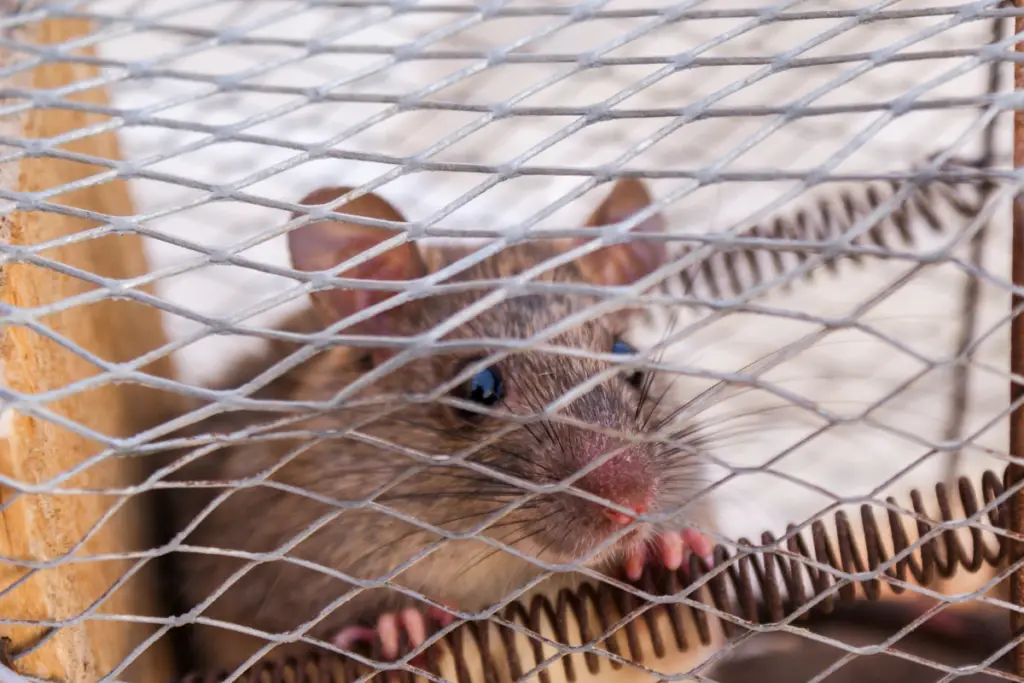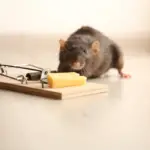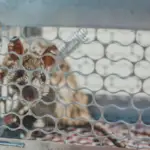Rat traps are a common tool used to control rat infestations. They are designed to catch and kill rats, preventing them from causing damage to homes and spreading diseases.
Rat traps come in various types, including snap traps, glue traps, and live traps, each with its own benefits and drawbacks.
Snap traps are the most common type of rat trap. They consist of a spring-loaded bar that snaps down on a rat when it takes the bait.
Snap traps are easy to use and inexpensive, making them a popular choice for homeowners.
However, they can be dangerous to pets and children if not used properly. Glue traps, on the other hand, are designed to catch rats alive by trapping them in a sticky substance.
Live traps are also available, which capture rats without harming them, allowing them to be released elsewhere.

Table of Contents
Types of Rat Traps
When it comes to trapping rats, there are several options available. Here are some of the most common types of rat traps:
Snap Traps
Snap traps, also known as traditional traps, are one of the oldest and most popular types of rat traps.
They consist of a wooden or plastic base with a metal bar that snaps down when triggered by the rat.
Snap traps are designed to kill rats instantly, making them a quick and humane way to control rat populations.
Prices pulled from the Amazon Product Advertising API on:
Product prices and availability are accurate as of the date/time indicated and are subject to change. Any price and availability information displayed on [relevant Amazon Site(s), as applicable] at the time of purchase will apply to the purchase of this product.
Glue Traps
Glue traps are another type of rat trap that are commonly used in homes and businesses.
They consist of a sticky adhesive that is spread over a flat surface, such as a piece of cardboard or plastic.
When a rat steps on the glue trap, it becomes stuck and is unable to move. Glue traps are considered to be a humane way to control rat populations, as they do not kill the rats.
Prices pulled from the Amazon Product Advertising API on:
Product prices and availability are accurate as of the date/time indicated and are subject to change. Any price and availability information displayed on [relevant Amazon Site(s), as applicable] at the time of purchase will apply to the purchase of this product.
Electronic Traps
Electronic traps are a newer type of rat trap that use electricity to kill rats. They consist of a plastic or metal box with an electronic circuit that delivers a lethal shock to the rat when it enters the trap.
Electronic traps are considered to be a humane way to control rat populations, as they kill rats quickly and painlessly.
Overall, there are several types of rat traps available, each with its own advantages and disadvantages.
Prices pulled from the Amazon Product Advertising API on:
Product prices and availability are accurate as of the date/time indicated and are subject to change. Any price and availability information displayed on [relevant Amazon Site(s), as applicable] at the time of purchase will apply to the purchase of this product.
When choosing a rat trap, it is important to consider factors such as the size of the rat population, the location of the infestation, and the level of humane treatment desired.
How Rat Traps Work
Rat traps are a common and effective way to control rat infestations.
They work by luring rats with bait and then killing them with a trigger mechanism.
Here’s how they work:
Trigger Mechanism
The trigger mechanism is what sets off the trap when a rat takes the bait. There are several types of trigger mechanisms, but the most common is the snap trap.
Snap traps consist of a metal bar that is held in place by a catch. When a rat takes the bait, it triggers the catch, releasing the metal bar and killing the rat instantly.
Baiting
Baiting is an important part of using a rat trap. The bait should be something that rats find irresistible, such as peanut butter, cheese, or bacon.
It’s important to use a small amount of bait, as too much can make it easy for rats to take the bait without triggering the trap.
It’s also important to place the bait in the right spot, as rats are cautious and will avoid anything that looks suspicious.
Prices pulled from the Amazon Product Advertising API on:
Product prices and availability are accurate as of the date/time indicated and are subject to change. Any price and availability information displayed on [relevant Amazon Site(s), as applicable] at the time of purchase will apply to the purchase of this product.
Killing Mechanism
The killing mechanism is what actually kills the rat once the trap has been triggered. Snap traps use a metal bar to kill rats, while electronic traps use a high-voltage shock.
Both types of traps are effective, but electronic traps are generally considered to be more humane, as they kill rats instantly without causing them any pain.
In summary, rat traps work by luring rats with bait and then killing them with a trigger mechanism.
They are an effective way to control rat infestations and are relatively easy to use. However, it’s important to use them correctly and safely to avoid harming pets or children.
Placement of Rat Traps
When it comes to rat traps, proper placement is key to catching rats effectively. This section will cover two sub-sections: Identifying Infestation Areas and Proper Placement Techniques.
Identifying Infestation Areas
Before placing traps, it is important to identify the areas where rats are most likely to be present.
Look for signs of rat activity such as gnaw marks, droppings, and nesting areas.
Rats tend to follow the same paths along walls and edges of rooms, so pay attention to these areas when identifying infestation areas.
Proper Placement Techniques
Once you have identified the infestation areas, it is time to place the traps. Here are some proper placement techniques to consider:
- Place the traps perpendicular to the wall, with the trigger end facing the wall.
- Place the traps in areas where rats are likely to be, such as near food sources or along travel routes.
- Space the traps out every few feet along the wall to increase the chance of catching rats.
- Use multiple traps to increase the chances of catching rats.
- Avoid placing traps in areas where children or pets can access them.
- Check the traps regularly and dispose of any dead rats promptly.
It is important to note that trapping rats is just one part of a comprehensive pest control plan.
To prevent future infestations, it is important to identify and eliminate the source of the infestation, such as sealing entry points and removing food sources.
Overall, the proper placement of rat traps is crucial for catching rats effectively.
By identifying infestation areas and using proper placement techniques, you can increase your chances of catching rats and preventing future infestations.
Maintenance of Rat Traps
When it comes to rat traps, maintenance is key to ensuring they remain effective. A poorly maintained trap can easily become ineffective, and even worse, it can become a health hazard.
In this section, we’ll look at the two most important aspects of maintaining rat traps: checking them regularly and disposing of dead rats.
Checking Traps Regularly
One of the most important things to do when maintaining rat traps is to check them regularly.
Depending on the type of trap you have, this may mean checking them every day, every few days, or once a week.
It’s important to check them regularly to ensure that they remain effective and to remove any dead rats that may have been caught.
When checking rat traps, there are a few things to look out for. First, make sure that the bait is still present and hasn’t been eaten.
If the bait is gone, it’s likely that a rat has been caught. Second, check to see if a rat has been caught. If a rat has been caught, remove it immediately.
Leaving a dead rat in a trap can attract other pests and create a health hazard.
Disposal of Dead Rats
When disposing of dead rats, it’s important to do so safely and hygienically. Dead rats can carry diseases, so it’s important to wear gloves and avoid touching them directly.
If possible, use a plastic bag to remove the dead rat from the trap and dispose of it in an outdoor trash can.
If you don’t have access to an outdoor trash can, double bag the dead rat and dispose of it in a regular trash can.
After disposing of a dead rat, it’s important to clean the trap thoroughly to remove any bacteria or germs that may have been left behind.
Use hot, soapy water to clean the trap, and then rinse it thoroughly. If the trap is reusable, make sure it’s completely dry before setting it up again.
In conclusion, regular maintenance of rat traps is essential to ensure their effectiveness and to prevent health hazards.
By checking traps regularly and disposing of dead rats safely and hygienically, you can keep your home or business free from rat infestations.
Conclusion
In conclusion, rat traps are designed to effectively capture and eliminate rats. These devices utilize various mechanisms and strategies to entice rats, capture them, and prevent their escape.
The two most common types of rat traps are snap traps and glue traps.
Snap traps are designed with a spring-loaded mechanism that snaps shut when triggered by the rat’s movement.
The trap is baited with food to attract the rat, and when the rat attempts to eat the bait, it triggers the trap, leading to a quick and lethal closure.
The force generated by the snap trap ensures a swift and humane kill, minimizing the suffering of the rat.
Glue traps, on the other hand, use a sticky adhesive surface to trap the rat. These traps are usually flat boards or trays coated with a strong adhesive.
Bait, such as food or a scent, is placed on the adhesive surface to attract the rat. When the rat steps onto the trap to reach the bait, it becomes stuck to the glue, immobilizing it.
Glue traps are effective in capturing rats alive, but they often raise ethical concerns due to the prolonged suffering experienced by the trapped rat.
Overall, rat traps serve as an essential tool in controlling rat populations and minimizing the risks they pose to human health and property.
By employing appropriate trapping techniques, selecting suitable baits, and maintaining a clean environment, rat traps can be effective in managing rat infestations and creating safer living spaces.
- How to Build a Planter Box for Bamboo: A Step-by-Step Guide

- Can Robotic Lawnmowers Handle Steep Slopes?

- Do You Need a Specific Lawn for a Robotic Lawnmower? Expert Advice

- Are Robotic Lawnmowers Safe for Pets and Children? Safety Features of Robotic Lawnmowers

- Why Use Robotic Lawnmowers? Advantages of Using a Robotic Lawnmower

- Is the GARDENA SILENO City 300 Cordless or Corded? A Clear Answer






































